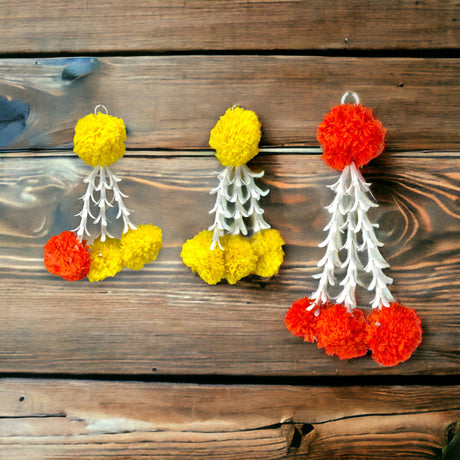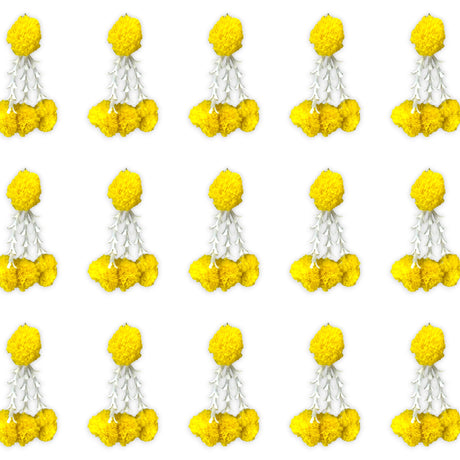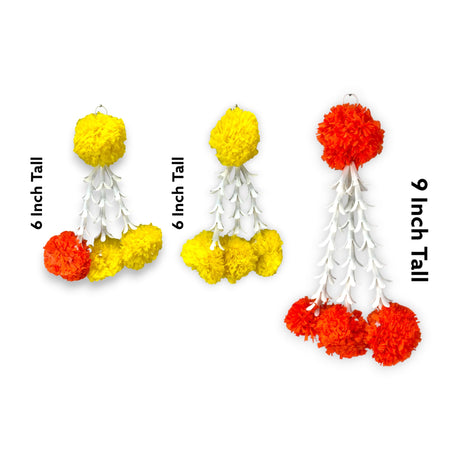Introduction
In Hindu mythology, Riddhi and Siddhi are revered as divine energies representing prosperity and spiritual achievement. Riddhi signifies material abundance and success in various aspects of life, while Siddhi represents spiritual fulfillment and inner peace. Together, they embody the dual goals of wealth and spiritual accomplishment.
Lord Ganesha, often depicted with his consorts Riddhi and Siddhi, is a significant deity who grants both material wealth and spiritual success. Known as the remover of obstacles, Ganesha is worshipped to ensure prosperity and wisdom.
This article explores the relationship between Ganesha and his consorts, Riddhi and Siddhi. We will discuss their symbolic meanings, the role of rituals in invoking their blessings, and how these practices can help harmonize material pursuits with spiritual growth.
1. Understanding Riddhi and Siddhi
What is Riddhi?
Riddhi is a divine energy associated with prosperity and abundance. It manifests in various aspects of life, including:
- Finances: Ensuring financial stability and growth.
- Relationships: Fostering harmonious and fulfilling personal connections.
- Health: Promoting physical well-being and vitality.
In simple terms, Riddhi symbolizes the material wealth and prosperity that enable individuals to lead a comfortable and satisfying life.
What is Siddhi?
Siddhi represents spiritual success and fulfillment, offering a deeper dimension of personal growth. Key aspects include:
- Inner Peace: Cultivating a state of calmness and tranquility within.
- Enlightenment: Achieving heightened awareness and understanding of one's self and the universe.
- Personal Growth: Embarking on a journey of continuous self-improvement and spiritual development.
Siddhi embodies the spiritual achievements that bring about a sense of fulfillment, enlightenment, and inner harmony.
By understanding the dual energies of Riddhi and Siddhi, we can appreciate the balanced approach to both material prosperity and spiritual growth that is integral to Hindu philosophy.
2. How Lord Ganesha Helps Us Attract Wealth and Success
Lord Ganesha is highly respected for his special qualities, especially as the one who removes obstacles. This ability is crucial for reaching both physical and spiritual objectives. Obstacles can come in many ways—money problems, health concerns, or even personal struggles. By seeking Ganesha's blessings, we can ensure a smoother journey by getting rid of these barriers, which in turn allows wealth and success to flow freely.
More Than Just Removing Obstacles
Ganesha's role goes beyond just getting rid of obstacles. He represents intellect and wisdom, two vital elements for dealing with life's challenges. His elephant head stands for vast knowledge and understanding, guiding people to make wise choices that lead to prosperity. Whether it's launching a new business or starting a spiritual quest, Ganesha's wisdom offers the insight needed to succeed.
Key Qualities of Lord Ganesha:
- Remover of Obstacles: Important for achieving material wealth and spiritual success.
- Intellect and Wisdom: Guides wise decision-making, crucial for long-term prosperity.
By embracing these qualities, followers can align themselves with both material abundance (Riddhi) and spiritual fulfillment (Siddhi), creating a balanced approach to life's goals.
3. The Divine Union: Ganesha with His Consorts Riddhi and Siddhi
The divine union of Lord Ganesha with his consorts Riddhi and Siddhi holds profound symbolic significance in Hindu mythology. This relationship embodies the harmony between material wealth and spiritual success, reflecting a balanced approach to life.
Symbolic Significance
- Riddhi: Representing prosperity, Riddhi encompasses all forms of material abundance—financial stability, thriving relationships, robust health, and overall well-being. You can even find beautiful Riddhi idols that serve as perfect spiritual gifts or decorative items.
- Siddhi: Signifying spiritual success, Siddhi includes inner peace, enlightenment, personal growth, and fulfillment beyond the material realm.
In their union with Ganesha, these energies symbolize the ideal blend of worldly achievements and spiritual enlightenment. The balance between Riddhi and Siddhi illustrates that true success is not just about accumulating wealth but also about achieving spiritual contentment.
Balance Between Material and Spiritual Pursuits
This divine marriage underlines a crucial message: prosperity (Riddhi) should be pursued without neglecting spiritual growth (Siddhi). For instance:
- A person can seek financial success while maintaining ethical values and a sense of inner peace.
- Engaging in practices that nurture both the mind and soul ensures holistic well-being.
Ganesha's role as a Tantric deity further accentuates this balance. In Tantric traditions, deities embody both material and spiritual energies, guiding devotees towards a harmonious existence.
The Riddhi Siddhi relationship thus teaches that the path to true abundance involves nurturing both external achievements and internal fulfillment. The Ganesha with Riddhi Siddhi goddess set beautifully encapsulates this divine union, serving as a reminder of the importance of balancing these two aspects in our lives.
4. Worship Practices to Invoke Abundance and Spiritual Fulfillment
Ganesh Chaturthi Rituals
Ganesh Chaturthi is a significant festival dedicated to Lord Ganesha, celebrated with enthusiasm throughout India. This special occasion involves elaborate puja rituals aimed at inviting both wealth (Riddhi) and spiritual blessings (Siddhi) into the lives of devotees.
Key rituals during Ganesh Chaturthi include:
- Installation of Ganesha Idol: Devotees bring home beautifully crafted idols of Ganesha, often accompanied by artistic depictions of Riddhi and Siddhi.
- Pranapratishtha: A ritual to invoke life into the idol, inviting the divine presence of Ganesha.
- Offerings: Devotees present offerings like modaks, coconuts, flowers, and durva grass to Ganesha, symbolizing their devotion and seeking his blessings.
- Aarti: Performed twice daily, this involves singing hymns and waving lamps before the deity, creating an atmosphere charged with spiritual energy.
Mantras for Abundance
Mantras are essential in invoking the energies of Riddhi and Siddhi. Specific chants are believed to attract wealth and spiritual fulfillment:
- Vakratunda Mahakaya
- "Vakratunda Mahakaya Suryakoti Samaprabha Nirvighnam Kuru Me Deva Sarva-Kaaryeshu Sarvada"
- This mantra is recited to remove obstacles and bring prosperity.
- Riddhi Siddhi Mantra
- "Om Shreem Hreem Kleem Gloum Gam Ganapataye Vara Varada Sarva Janamme Vashamanaya Svaha"
- Dedicated specifically to invoking the blessings of Riddhi and Siddhi, this mantra aims to harmonize material wealth with spiritual growth.
- Ganapati Atharvasirsha
- This Vedic hymn praises Ganesha's virtues, aligning the devotee's intentions with divine will for holistic well-being.
Consistent practice of these rituals and mantras promotes a balanced approach to life, integrating both material abundance and spiritual enlightenment.
5. Regional Variations in Worshiping Ganesha: A Cultural Perspective
Regional variations in worshiping Ganesha reflect India's rich cultural tapestry, with each area infusing unique rituals and interpretations into their celebrations.
Maharashtra
- Ganesh Chaturthi is celebrated with grandeur.
- Elaborate pandals (temporary structures) house large idols of Ganesha, often accompanied by smaller figures of Riddhi and Siddhi.
- Rituals like aarti (devotional songs) and offerings of modak (sweet dumplings) are common.
Tamil Nadu
- Known as Vinayaka Chaturthi.
- Emphasis on eco-friendly idols made from clay.
- Traditional food offerings include kozhukattai (rice dumplings), symbolizing prosperity.
Karnataka
- Celebrations involve community gatherings and processions.
- Unique ritual: Gowri Habba, preceding Ganesh Chaturthi, honors Goddess Parvati, Ganesha's mother, invoking blessings for familial prosperity.
West Bengal
- Blends with the region's artistic heritage.
- Idols often feature intricate designs, reflecting local craftsmanship.
- Rituals incorporate elaborate aarti ceremonies and cultural performances.
Andhra Pradesh
- Known for Clay Ganapati festivals.
- Devotees create clay idols at home.
- Rituals focus on simplicity, emphasizing spiritual growth over material abundance.
Each region’s distinctive practices highlight the diverse ways in which Indians honor Ganesha, Riddhi, and Siddhi. These variations underscore the adaptability of worship traditions to local customs and values.
6. Artistic Expressions of Prosperity: Ganesha with Riddhi and Siddhi in Art
Artistic depictions of Ganesha with Riddhi and Siddhi capture the essence of prosperity and spiritual fulfillment. Artists have skillfully portrayed this divine trio in various mediums, each piece reflecting cultural reverence and artistic prowess.
Sculptures
In temples and homes, sculptures of Ganesha often include Riddhi and Siddhi by his side. These sculptures typically feature:
- Intricate carvings: Showcasing detailed ornamentation symbolizing wealth (Riddhi) and enlightenment (Siddhi).
- Dynamic poses: Ganesha seated majestically with his consorts, signifying balance between material abundance and spiritual growth.
Paintings
Traditional paintings bring to life the vibrant connection between Ganesha, Riddhi, and Siddhi:
- Mughal miniatures: Delicately painted scenes where Ganesha is flanked by his consorts, each holding symbols of prosperity and success.
- Modern interpretations: Contemporary artists use bold colors and abstract forms to represent the harmonious union of wealth and spirituality.
Digital Art
The digital age has seen a surge in innovative portrayals:
- Graphic designs: Featuring stylized versions of Ganesha with Riddhi and Siddhi, often used in festive greetings or digital wallpapers.
- 3D models: Creating immersive experiences that allow viewers to explore the divine trio from multiple angles.
These artistic expressions not only celebrate the divine attributes of Ganesha but also serve as reminders of the importance of balancing material pursuits with spiritual growth. Each piece is a testament to the cultural significance of Riddhi Siddhi Ganesh in manifesting wealth and success through both art and devotion.
Conclusion: Finding Balance for a Fulfilling Life
The story of Riddhi and Siddhi teaches us an important lesson about balancing our material goals with our spiritual growth. It's a reminder that while we strive for financial stability, we must also make time to nurture our inner selves.
- Riddhi represents prosperity and abundance, guiding us towards financial success.
- Siddhi embodies spiritual fulfillment, leading us to inner peace and enlightenment.
By embracing both aspects represented by Riddhi and Siddhi, we can find harmony in our lives. This means that as we work towards building wealth, we should also prioritize our spiritual development. When we achieve this balance, our lives become richer and more meaningful.
This balance not only benefits us individually but also strengthens our connections with others. It allows us to create a sense of community that is rooted in both our cultural heritage and modern lifestyle.




































































